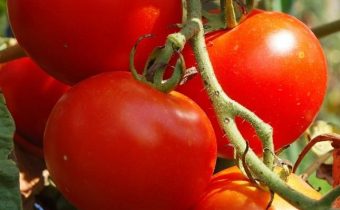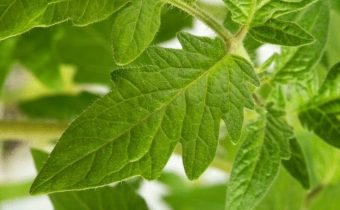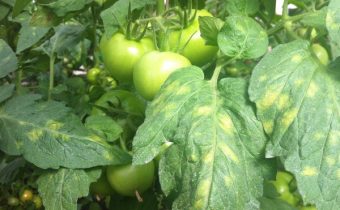How to feed tomatoes that grow poorly?
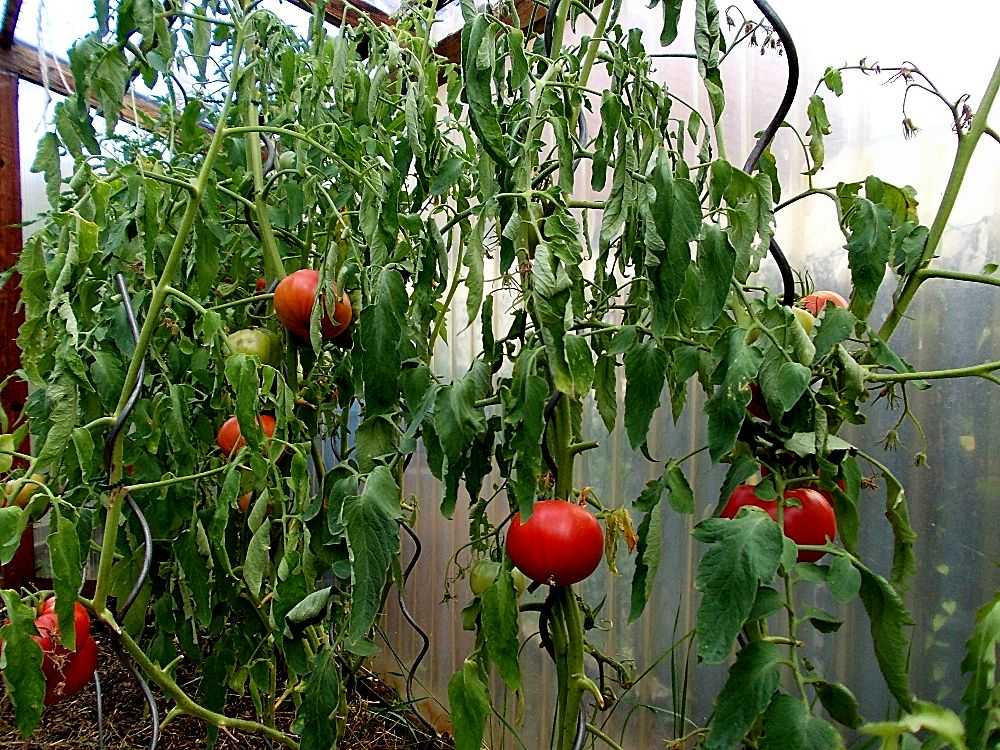
Knowing that without proper care you will not get a harvest, gardeners carefully nourish tomatoes. And it is understandable grief, when you see that tomatoes grow poorly, "leave" in the greens and give a small number of ovaries. To change the situation, you need to deal with the causes, and then solve the problem.
Causes of poor tomato growth
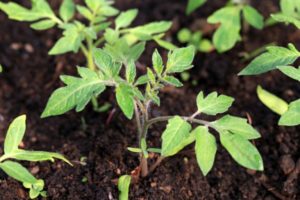
Growth delay in tomatoes can occur at any stage of the growing season:
- growing seedlings;
- after landing on the open ground beds or shelters (greenhouses, greenhouses, tunnels);
- in the midst of flowering, fruiting.
Main reasons:
- Poor quality planting material.
- Incorrect picking of seedlings (deadlines, damage to the roots). When sowing plants in common boxes or containers, they dive with the appearance of 2-3 true leaves.
- Poor soil quality.
- The low temperature of the soil in which the tomatoes grow. Usually manifested in seedlings grown on cold window sills. Boxes and pots are put on planks or foam to avoid contact with the surface of the sills.
- Lack of power. In adult tomatoes, it appears when thickened plantings, non-compliance with the distance between plants during planting. The bulk of the roots is formed in the arable layer, at a depth of 20 cm. With a small area, the root system develops slowly, while it is not able to provide plants with nutrition. When planting tomatoes, take into account the type of plant: super determinant placed on 5-6 bushes per 1 square. meter; determinant - no more than 4-5 plants; indeterminant - 1-3 bush each.
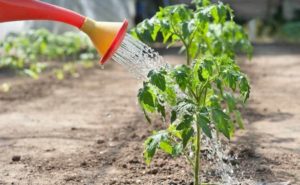 Violations of temperature. Culture likes warm, favorable indicators for the growth of tomatoes: + 24ºC ... + 28 ºC, below + 15ºC and above + 32ºC pollination of plants is impossible. Shrubs, though slowly, will grow, but the color will fall, the ovaries will not. Comply with the regime, airing shelters on hot days through the doors, vents, transom.
Violations of temperature. Culture likes warm, favorable indicators for the growth of tomatoes: + 24ºC ... + 28 ºC, below + 15ºC and above + 32ºC pollination of plants is impossible. Shrubs, though slowly, will grow, but the color will fall, the ovaries will not. Comply with the regime, airing shelters on hot days through the doors, vents, transom.- Increased humidity levels. In the beds, plants rarely get into this situation, but in greenhouse tomatoes, growth retardation is often associated with high humidity in the shelter. Output - regular airing, soil mulching, loosening after irrigation. The extra leaves on the plants are removed (no more than 1-2 copies at a time) in order to provide air access.
- Irregular watering. Tomatoes are watered 1-2 times a week, deeply moistening the soil. During the fruit set, watering volumes increase, 2 weeks before harvesting - stop. When visiting the dacha only on weekends, it is necessary to arrange drip irrigation for the tomatoes, otherwise it is impossible to avoid cracking the fruit.
- Unbalanced by elements and dosage dressing. A deficiency or excess of nutrients leads to a serious delay in plant growth, low fruit set, and yellowing of leaves. Growth of tomatoes is inhibited due to the lack of nitrogen, which is necessary for plants in the first half of the growing season. Bushes stop developing, leaves shrink, change color from bright green to pale, then turn yellow.On a note!
An excess of nitrogen is dangerous when the plant “fats”, releases a large number of leaves, but gives little color. Requires urgent fertilization with potash and phosphate fertilizers, elimination of nitrogen from fertilizers.The lack of trace elements is filled with foliar top dressing (solutions of boric acid, superphosphate, infusion of ash).
- Disease. They are particularly annoying the tomatoes in the second half of summer, when the air temperature drops. All kinds of infections are dangerous: fungal, viral, bacterial.
- Pest attacks. Many insect pests are “interested” in representatives of the family of solanaceae, including the whitefly, the wireworm, the aphid, the nematode, and the bear. Without prophylaxis and prompt adoption of protection measures (in the event of pests), tomatoes slow down their growth, dry out and die.
If you notice that the plants are lagging behind in development, the color falls or there are few ovaries, immediately find out the reasons, and then quickly begin to correct the situation.
How to feed tomato seedlings
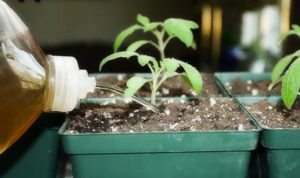
In the arsenal of gardeners - a large amount of fertilizers and drugs to stimulate the growth of tomatoes. Sowed in nutrient soil, diving tomatoes do not particularly need feeding. But if there is a lag in growth, use ready-made compositions Mortar or Kemira-Lux. The content of the elements in them is balanced, and it is enough to act in full accordance with the instructions.
After the dive, the Uniflor-bud compositions are suitable (dilute one teaspoon with 2 liters of water), ash infusion (a tablespoon is diluted with two liters of warm water, infused for 24 hours), nitrophoska.
What to feed tomatoes in the beds
During the growing period, the following compounds are used to support tomatoes in the open field:
- Ash infusion (a glass of ash in a bucket of water), insist 2-3 hours. Water the bushes once every 10 days, the rate is 1-1.5 liters under the bush.
- In a bucket of water (10 liters) dissolve the superphosphate (two tablespoons), stand a day. Then add 0.5 liters of mullein or chicken manure, a spoonful of potassium sulfate. All mixed, watered plants, contributing a liter for each tomato.
- In a liter of whey, dilute 10 drops of iodine, pour the composition into a bucket of water (9 liters), receiving a total volume of 10 liters. Mix, bring under a bush on 1,5-2 liters of top dressing.
- Dry the coffee grounds, put it into the soil in the wells with tomatoes. Carefully water the plants under the root.
- Yeast composition, through which tomatoes grow rapidly and form a large number of ovaries. 200 grams of yeast diluted in a liter of warm water, add a spoonful of sugar. Stir, add 5-6 liters of water. Stand the composition a couple of days, then feed the tomatoes.
Yeast dressings are carried out 1-2 times per season.
Than feed tomatoes in the greenhouse
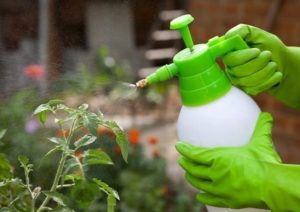
To stimulate the growth of greenhouse tomatoes effective formulations:
- Korovyak is diluted in water 1:10, insist 3-4 days, then once again diluted with water 1: 5 and water the plants (2 liters under a bush).
- Humeat (tablespoon) is stirred in a bucket of water, a spoon of any complex fertilizer is added, mixed. Bring under a bush to stimulate plant growth (norm - 0.5 liters).
- Potassium humate (a tablespoon) is diluted in a bucket of water, 0.5 liters are added under the shrub to increase the number of ovaries, good growth.
From foliar treatments recommended compounds with trace elements:
- Boric acid is diluted in a liter of warm water. Add urea, copper sulfate (all preparations per teaspoon). Stir, add water to the full volume of 10 liters, spray the plants on the leaves.
- Superphosphate (a teaspoon) is diluted in a bucket of water, insisting until complete dissolution a day. Tomato bushes are processed during the formation of ovaries.
Biological growth stimulants
Various growth stimulants “work” on natural components. They are also used to improve the growth of the root system, plant development, and increase yields.
Agat-25K
The preparation contains needles extract fractions, strains of beneficial bacteria, micronutrient doses. Used to enhance the growth of tomatoes, suppressing dangerous fungal infections. Available in the form of a viscous paste.
Processed tomatoes on the leaves of the working solution: 140 milligrams dissolved in three liters of warm water.
Biogrove
Bioactivator consists of a mixture of humic acids, flao-bacteria. Also included are biologically active water, wood ash and blood meal concentrate. Product form: 150, 500 ml bottles (paste or liquid).
Tomatoes are used for watering (once in 30 days). Working solution: a teaspoon to five liters of water. The drug is used if the tomatoes grow slowly in the open field, for a long time there is inclement weather and the plants do not bloom well, "give" a small number of ovaries.
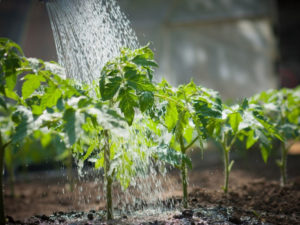
Agromax
A natural product that contains azotobacteria, humic acid, water with a low content of air gases, concentrated dry blood.
The use of bioactivator not only promotes the growth of tomatoes, but also improves the soil structure, improves immunity. Significantly improves the taste of tomatoes.
For irrigation, dissolve a bag of the drug in a bucket of water, pour it directly into the hole.
Biostim
The use of this drug enhances the phase growth of the culture, gives rise to a sprouting, provides an increase in yield. Processing is allowed 3 times per season.
First, make the mother liquor: pour the contents of the bag in hot water (50 ml), leave to cool. The composition is removed in the refrigerator (stored up to 1.5 months). Before treatment, dilute 1 ml of the composition in 1 liter of water. Consumption: liter per 5 square meters of landings.
The main help to tomatoes in a situation when they slow down growth is timely feeding. It is necessary to find out the causes of "braking", and then quickly take all measures to eliminate the problem.


